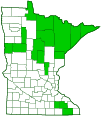tall bluebells
(Mertensia paniculata var. paniculata)
Conservation • Wetland • Description • Habitat • Ecology • Use • Distribution • Taxonomy
Conservation Status |
|
|||||||
| IUCN Red List | not listed |
|||||||
| NatureServe | NNR - Unranked SNR - Unranked |
|||||||
| Minnesota | not listed |
|||||||
Wetland Indicator Status |
||||||||
| Great Plains | FAC - Facultative |
|||||||
| Midwest | FAC - Facultative |
|||||||
| Northcentral & Northeast | FAC - Facultative |
|||||||
Description |
||
Tall bluebells is a 12″ to 40″ tall, erect, perennial forb that rises on usually multiple stems from a fibrous caudex or stout rhizome. It is often found in clumps. It is not colonial. The stems are fragile, fleshy, leafy, hairless or sparsely hairy, and branching near the top. Leaves are hairy on both sides. Basal leaves, when present, are heart-shaped to egg-shaped, 2″ to 8″ long, 1″ to 4″ wide, and taper at the base to a 6″ to 12″ long, winged leaf stalk. They are distinctly veined. Stem leaves are numerous, on shorter stalks, alternate, thin, lance-shaped to egg-shaped, with pointed tips. Lower stem leaves are 2″ to 5½″ long, and ⅔″ to 2¾″ wide, becoming gradually smaller as they ascend the stem. The uppermost leaves are greatly reduced in size and are attached to the stem without a leaf stalk. The margins are untoothed. The inflorescence is is a small, branched cluster at the end of the stems. The cluster is on a hairy stalk. The flowers are trumpet-shaped, downward hanging, and ⅓″ to ½″ long. There are 5 petals that are purplish pink when in bud, gradually turning light blue as they unfold. They are fused at the base into a tube that flares outward at the tip with 5 shallow lobes. The expanded portion of the corolla (limb) is 1.2 to 1.6 times as long as the tube. The individual flowers are never subtended with leafy bracts. The fruit is 0 to 4 wrinkled nutlets per flower. |
||
Height |
||
12″ to 40″ |
||
Flower Color |
||
Blue |
||
Similar Species |
||
Virginia bluebells (Mertensia virginica) is a shorter, hairless, often colonial plant with larger, showier flowers. It reaches no more than 26″ in height. The stems and leaves are hairless. Upper stem leaves have rounded tips. The flowers are ¾″ to 1″ long. The corolla tube is longer than the limb. |
||
Habitat |
||
Moist. Woods. |
||
Ecology |
||
Flowering |
||
June to July |
||
Pests and Diseases |
||
|
||
Use |
||
|
||
Distribution |
||||
|
Sources |
|||
| 4/22/2023 | ||||
Nativity |
||||
Native |
||||
Occurrence |
||||
|
||||
Taxonomy |
|||
| Kingdom | Plantae (green algae and land plants) | ||
| Subkingdom | Viridiplantae (green plants) | ||
| Infrakingdom | Streptophyta (land plants and green algae) | ||
| Superdivision | Embryophyta (land plants) | ||
| Division | Tracheophyta (vascular plants) | ||
| Subdivision | Spermatophytina (seed plants) | ||
| Class | Magnoliopsida (flowering plants) | ||
| Superorder | Asteranae | ||
Order |
Boraginales (borages) | ||
Family |
Boraginaceae (borage) | ||
| Subfamily | Cynoglossoideae | ||
| Tribe | Asperugeae | ||
Genus |
Mertensia (bluebell) | ||
| Section | Mertensia | ||
| Species | Mertensia paniculata (tall bluebell) | ||
Subordinate Taxa |
|||
|
|||
Synonyms |
|||
Mertensia palmeri Mertensia pilosa |
|||
Common Names |
|||
northern bluebells northern lungwort tall bluebells tall mertensia |
|||
Glossary
Bract
Modified leaf at the base of a flower stalk, flower cluster, or inflorescence.
Caudex
A short, thickened, woody, persistent enlargement of the stem, at or below ground level, used for water storage.
Corolla
A collective name for all of the petals of a flower.
Limb
In flowers, the expanded portion of a petal, or the expanded part of a corolla, above the throat.
Rhizome
A horizontal, usually underground stem. It serves as a reproductive structure, producing roots below and shoots above at the nodes.
Winged leaf stalk
A leaf stalk with a leaf-like or membrane-like extension along both sides.
Visitor Photos |
|||||
Share your photo of this plant. |
|||||
| This button not working for you? Simply email us at info@MinnesotaSeasons.com. Attach one or more photos and, if you like, a caption. |
|||||
|
|||||
MinnesotaSeasons.com Photos |
|||||
|
|||||

Slideshows |
||

Visitor Videos |
|||
Share your video of this plant. |
|||
| This button not working for you? Simply email us at info@MinnesotaSeasons.com. Attach a video, a YouTube link, or a cloud storage link. |
|||
Other Videos |
|||

Visitor Sightings |
|||||
Report a sighting of this plant. |
|||||
| This button not working for you? Simply email us at info@MinnesotaSeasons.com. Be sure to include a location. |
|||||
|
|||||
MinnesotaSeasons.com Sightings |
|||||
|
|||||

|
Created: Last Updated: © MinnesotaSeasons.com. All rights reserved. |
